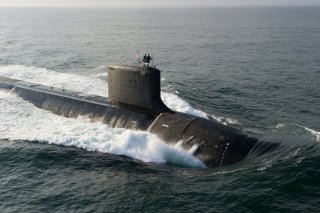SSN(X): The Navy Will Soon Have the World's Deadliest Attack Submarine
The Navy's next-generation submarine, known as SSN(X), is expected to be larger than the Virginia class, and still be the stealthiest nuclear submarine ever put to sea.
Here's What You Need to Remember: The next generation of new attack submarines is several years away, but it can be expected to incorporate a host of new technologies. The U.S. Navy’s next-generation attack submarines will be larger than the existing fleet of Virginia-class attack submarines, a plan that could enable greater weapons payloads, longer service life and a host of not-yet-seen quieting technologies. The Navy has begun work on a new generation of attack submarines with never-before-seen weapons, quieting technology, undersea attack drones, sonar and communications networking . . . to emerge in the 2030s. The as-of-yet unnamed class of attack submarine, now referred to as SSN(X), will have a larger diameter, according to the chief executive of one of the major vendors working on nuclear propulsion for the submarines, BWX Technologies. “We do expect it will be a larger type of submarine, probably in the size class of the Columbia, but there’s not much more to tell than that. But we’re working with our Navy customer in what that would look like and how we could take that into production,” Rex Geveden said, according to a quote cited in a story from The U.S. Naval Institute. Will it be the stealthiest, most lethal attack submarine ever to exist? That is the Navy’s plan. Plans for a next-generation attack submarine, as explained by Navy weapons developers, include launching long-range precision strikes, delivering Special Operations Forces on secret high-risk attack missions, conducting ISR missions, networking with platforms and—perhaps of greatest significance—operating undetected in high-threat waters. As part of the development for the boats, the Navy conducted a “SOF Optimization” Analysis of Alternatives to, among other things, find ways to engineer an attack submarine well suited for clandestine undersea SOF missions. These can include targeted attack operations, forward intelligence gathering or high-risk surveillance missions, among other things. While particular technical details are often unavailable given the secret nature of these kinds of platforms, over the years senior Navy weapons developers have talked to the National Interest about some of the key areas of modernization focus; these include new coating materials to make the submarines stealthier, new antennas for longer-range, more accurate undersea surveillance missions and new “quieting” engine propulsion technology, among other things. All of these technologies, in fact, already exist in the USS South Dakota attack submarine—the most advanced submarine ever to be delivered to the Navy. The new boat, which is now operational, began as a prototype, test-bed platform to evolve these new technologies. What all of these USS South Dakota innovations are informing current conceptual discussions now underway for the new generation of attack subs. The technical elements of undersea command and control for the new submarines, quite naturally, are likely being engineered with a mind to an expected increased use of underwater drones. The Navy is now moving quickly with efforts to build an entire new fleet of UUVs able to destroy mines, conduct lower risk forward surveillance, deliver supplies or even fire weapons with a “human-in-the-loop.” Navy developers have explained this in recent years, explaining how the service’s now in development Orca XLUUV—Extra Large Unmanned Undersea Vehicle—is being configured to fire torpedoes. Also, according to congressional testimony in 2016, former Program Executive Officer Submarines Rear Adm. Michael E. Jabaley Jr., the USS South Dakota includes a DARPA-engineered Hybrid Propulsor “which brings new acoustic advantages.” Kris Osborn serves as Defense Editor for the National Interest. He previously served at the Pentagon as a Highly Qualified Expert with the Office of the Assistant Secretary of the Army - Acquisition, Logistics & Technology. Osborn has also been an anchor and on-air military analyst for national TV networks. This article first appeared earlier in 2021 is being republished due to reader interest. Image: Reuters.

